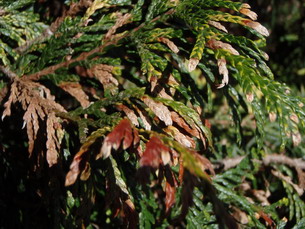Cypress Canker (Seiridium spp) / Cypress Dieback
Treetec has ceased offering treatments for Cypress dieback.
Australia has seen an explosion in the occurrence of Cypress dieback (Cypress Canker) on various exotic Cypress trees.
 Fungal spores enter a tree through wounds in the bark which could be pruning cuts, cracks, insect holes, storm damage to limbs etc and interfere with the conducting system of the Cypress tree. The spores are usually spread by wind and water splash.
Fungal spores enter a tree through wounds in the bark which could be pruning cuts, cracks, insect holes, storm damage to limbs etc and interfere with the conducting system of the Cypress tree. The spores are usually spread by wind and water splash.
Usual symptoms include dieback from the top of the tree down or selected branches browning and dying throughout the canopy, a branch can change colour over a period of days.
You may (but not always) see thin, elongated cankers on the stems, branches and branch axils. These cankers cause twig and branch dieback. Most cankers are wounds, slightly sunken, with raised margins, and they may be discoloured dark brown to purple.  Cracked bark in infected areas is often accompanied by extensive resin exudates that flow down the diseased branches and trunk. The cambial tissue beneath oozing sites is discoloured with a reddish to brown colour. Once most of the canopy has browned off that limb or that tree will almost certainly die.
Cracked bark in infected areas is often accompanied by extensive resin exudates that flow down the diseased branches and trunk. The cambial tissue beneath oozing sites is discoloured with a reddish to brown colour. Once most of the canopy has browned off that limb or that tree will almost certainly die.
We believe the long period of dry conditions weakened the trees, particularly the root systems, they have then been hit with a period of above average rainfall and optimum conditions for fungal attack. The trees have been damaged and stressed making them susceptible to dieback from a range of fungal diseases. It is highly likely that the disease is the secondary problem (the final straw) and the primary issue is tree stress which is making trees susceptible to attack.
Susceptible trees
Monterey Cypress (Cupressus macrocarpa), Lambert’s Cypress (Cupressus lambertiana), Lawson’s Cypress (Chamaecyparis lawsoniana), Italian Cypress (Cupressus sempervirens), Arizona Cypress (Cupressus arizonica), False Cypress or Lawson’s Cypress (Cupressus lawsoniana), hybrids: x Cupressocyparis leylandii including cultivars ‘Castlewellan Gold’, ‘ Leighton’s Green’, ‘Naylor’s Blue’, and ‘Swane’s Golden’. There are other susceptible species.

Less susceptible trees
Arizona Cypress (Cupressus arizonica), Mexican Cypress (Cupressus lusitanica) Bhutan Cypress (Cupressus torulosa), Western Red Cedar (Thuja plicata), Thuja occidentalis, Juniperus virginiana
Treatment of cypress / conifer dieback
Treetec has in previously treated Cypress dieback on an experimental basis with foliar spray and stem injection of Phosphonic acid (phosphonate), sometimes combined with one or two other treatments. There have been some properties where this has delayed the onset of dieback. After some years of these treatments our team concluded that this was a temporary option at best and sometimes of no benefit. Due to the low success rate we no longer offer this service. This treatment was based on the chemical ‘turning on’ the plants natural defences, it did not act directly on the pathogen, this effect wore off over time therefore we think that precise timing is important and it may be unwise to use this application until initial signs of dieback are observed.
Pruning may be a treatment option (see below), other than this we are not aware of any other established treatment options aside from optimising growing conditions. This means making sure the trees are at maximum health. Tree health is primarily related to soil condition and we are currently working with a range of experts including soil scientists to develop an alternative treatment.
Plant health
In the meantime there are a number of things to consider:
- Adequate water but never waterlogged
- minimise soil compaction
- thin (7cm) layer of mulch, preferably irregular sized pieces that allow transition of air and water
- Analyses of soil and where appropriate amelioration to optimise condition; considering acidity, nutrients and biology
- Avoid wounding of trees, including from pruning cuts when fungal spread is likely, germination and spread of Seiridium can occur between 5 and 35 degrees C, optimally around 25 degrees C, relatively high humidity and / or rain suit the spread of the pathogen.
Treatment through pruning may be possible, this involves removing diseased sections of the tree, this will only be possible where symptoms are mild. Branches should be removed 10cm below the affected area and cankers on trunks can be removed where the size of the affected area is not too large. The cankered tissue is identified and the bark and cambium just beyond the diseased area is surgically removed with a scalpel under sanitary conditions, this wound should then be sealed with a resin, a fungicide can also be applied at this point.
All affected material, branches or trees, should be removed and burned to reduce the spread to nearby healthy trees.
